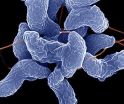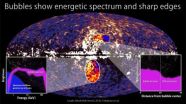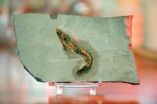(Press-News.org) Killing microorganisms has become a national obsession. A pair of antimicrobial compounds known as triclosan and triclocarban are lately the weapons of choice in our war of attrition against the microbial world. Both chemicals are found in an array of personal care products like antimicrobial soaps, and triclosan also is formulated into everyday items ranging from plastics and toys to articles of clothing.
But are these antimicrobial chemicals, as commonly used by people across the nation, really safe for human health and the environment? More pointedly, do they even work? According to associate professor Rolf Halden, of the Biodesign Institute at Arizona State University, the answer to these questions is an emphatic "No."
A biologist and engineer, Halden is interested in chemicals produced in high volume for consumer use. "I follow the pathways of these substances and try to figure out what they do to the environment, what they do to us and how we can better manage them."
The antimicrobial triclosan was patented in 1964, and began its use in clinical settings, where it was found to be a potent bacterial killer, useful before surgical procedures. Since then, industry's drive to convince consumers of the need for antimicrobials has been aggressive and highly effective. Antimicrobials made their first appearance in commercial hand soaps in the 1980s and by 2001, 76 percent of liquid hand soaps contained the chemical.
Antimicrobials have become a billion dollar a year industry and these chemicals now pervade the environment and our bodies. Levels of triclosan in humans have increased by an average of 50 percent since 2004, according to newly updated data from the Centers for Disease Control and Prevention (CDC).Triclosan and triclocarban are present in 60 percent of all rivers and streams nationwide and analysis of lake sediments have shown a steady increase in triclosan since the 1960s. Antimicrobial chemicals appear in household dust where they may act as allergens, and alarmingly, 97 percent of all U.S. women show detectable levels of triclosan in their breast milk. Such unnecessary exposures carry risks which, at present, are ill-defined.
Halden and his team conducted a series of experiments aimed at tracking the environmental course of the active ingredients in personal care products. The disturbing results of their research indicate that triclosan and triclocarban first aggregate in wastewater sludge and are transferred to soils and natural water environments, where they were observed to persist for months or years.
The chemistry behind these compounds, which contain benzene ring structures that have been chlorinated, make them notoriously difficult to break down. Further, they are averse to water or hydrophobic, tending to stick to particles, which decreases their availability for breakdown processes and facilitates long-range transport in water and air. A recent study demonstrated the accumulation of triclosan in dolphins from contaminated coastal waters.
Earlier, the EPA had been provided with industry-funded studies of wastewater treatment plant effluent, seemingly indicating elimination of triclosan and triclocarban during the treatment process. But Halden speculated that these chemicals might in fact persist in the solid byproduct left over after treatment—the sewage sludge. The group's suspicions were confirmed through an initial testing of a large wastewater treatment plant serving 1.3 million people, located in the Mid Atlantic region of the U.S.
In the first study of its kind, conducted by the team in 2006, it was determined that three quarters of the mass of triclocarban entering the wastewater treatment facility was simply moved from the water into the sludge. Similar tests confirmed the accumulation of triclosan in sludge with 50 percent efficiency.
"We make 13 billion pounds of dry sludge per year," Halden notes. "That is equal to a railroad train filled with sludge stretching 750 miles from Phoenix to San Francisco." One half of this sludge winds up on agricultural fields. The potential for these chemicals to migrate into food or leach into groundwater, has not received adequate consideration. It is likely that antimicrobials are capable of moving up the food chain, through a process known as biomagnification.
Both triclosan and triclocarban have been linked to endocrine disruption, with potential adverse impacts on sexual and neurological development. Further, the accumulation of these antimicrobials in the environment is exerting selective pressure on microorganisms exposed to them, thereby increasing the likelihood that a super-bug, resistant to the very antimicrobials developed to kill them, will emerge—with potentially dire consequences for human health.
On the positive side, Halden's team identified specific microorganisms adapted to not only tolerate but also break down pervasive antimicrobials. The research is part of a wider effort aimed at alerting the public and regulatory agencies, including the EPA and FDA, of the dangers of these chemicals as well as developing effective remediation strategies.
As Halden explains, "these microbes have the dual advantage of being resistant to destruction by antimicrobials and being able to break down these chemicals. You could put them to use for example by adding them to high-strength industrial wastewater before it gets combined with the domestic sewage."
In the group's recent studies, appearing in Water Research and The Journal of Hazardous Materials, levels of triclosan and triclocarban were measured, to determine the degree to which these chemicals, along with other antimicrobials, become concentrated in sludge, and what happens to them thereafter. Triclosan and triclocarban account for two-thirds of the mass of all the antimicrobials in sludge, Halden found, based on a survey of 72 chemicals entering the wastewater treatment stream. Further, massive bioaccumulation of antimicrobial chemicals has been observed in various species. Earthworms exposed to triclosan, for example, showed accumulation of the chemical by a factor of 2700 percent.
Halden notes the impact these persistent chemicals can have on other life forms in the environment that are not their intended target. The thresholds for killing microbes are much higher than those for other, more fragile life forms, like algae, crustaceans and fish. "This explains why residual concentrations of antimicrobials found in aquatic environments are still sufficiently harmful to wipe out the small and sensitive crustaceans, which are critical to the aquatic life cycle and food web," Halden says.
For certain, chemicals like triclosan and triclocarban have their place in public health, particularly in clinical settings, among people who are trained in their proper use. However, in 2005, the FDA put together an expert panel to review all the available information on these chemicals. Halden was among the voting members of this committee, which concluded that regular use of antimicrobial products by the general public was no more effective than traditional methods of proper hygiene—simply washing thoroughly with regular soap and water.
Society, Halden insists, is participating in a grand experiment in which we are all guinea pigs. While effective regulation of these chemicals is badly needed, Halden says that the inertia of regulatory agencies is a formidable obstacle. In the meantime, the best hope is for consumers to avoid triclosan and triclocarban containing products.
"The culture of fear leads people to make impulsive decisions and buy a lot of antimicrobial products that are not really needed," Halden says. "It's a profitable market to be in, but not one that is ultimately sustainable or a good idea."
INFORMATION:
In addition to Halden's appointment at the Biodesign Institute, at Arizona State University, he holds the title of associate professor in the School of Sustainable Engineering and the Built Environment, at the Ira. A. Fulton School of Engineering, ASU.
Written by Richard Harth
Biodesign Institute at ASU
Science Writer
richard.harth@asu.edu
Myth of a germ-free world: A closer look at antimicrobial products
2010-11-10
ELSE PRESS RELEASES FROM THIS DATE:
Overcoming the IVF baby blues
2010-11-10
Between 20 and 30 percent of women who undergo in vitro fertilization (IVF) procedures suffer from significant symptoms of depression. Many practitioners believe that the hormone therapy involved in IVF procedures is primarily responsible for this. But new research from Tel Aviv University shows that, while this is true, other factors are even more influential.
According to Dr. Miki Bloch of Tel Aviv University's Sackler Faculty of Medicine and the Sourasky Medical Center in Tel Aviv, stress, pre-existing depression, and anxiety are more likely than hormone therapy ...
Improving soil for better lawns and gardens
2010-11-10
U.S. Department of Agriculture (USDA) scientists in West Virginia are finding ways to improve soil on degraded land so it can be used for sports fields and other uses.
Researchers with USDA's Agricultural Research Service (ARS) at the agency's Appalachian Farming Systems Research Center (AFSRC) in Beaver, W.Va., are developing constructed or replacement subsoils and topsoils to build better and less-costly sports fields, raingardens and lawns on former landfills, mine lands and other degraded land. ARS is USDA's principal intramural scientific research agency.
The constructed ...
Sick at work and surfing the net? You're not alone -- or are you?
2010-11-10
ANN ARBOR, Mich.---Some scholars estimate that presenteeism, a relatively recent buzzword that applies to people who are less productive at work because of health issues, costs employers as much as three times the dollar amount as absenteeism in terms of lost productivity.
But researchers at University of Michigan believe those numbers may be inaccurate. A new opinion paper suggests that the tools for measuring and quantifying hours of lost productivity and translating those hours to dollars are unreliable and don't capture the entire presenteeism picture, said Susan ...
NASA's Fermi telescope discovers giant structure in our galaxy
2010-11-10
WASHINGTON -- NASA's Fermi Gamma-ray Space Telescope has unveiled a previously unseen structure centered in the Milky Way. The feature spans 50,000 light-years and may be the remnant of an eruption from a supersized black hole at the center of our galaxy.
"What we see are two gamma-ray-emitting bubbles that extend 25,000 light-years north and south of the galactic center," said Doug Finkbeiner, an astronomer at the Harvard-Smithsonian Center for Astrophysics in Cambridge, Mass., who first recognized the feature. "We don't fully understand their nature or origin."
The ...
Researchers discover important link between adrenal gland hormone and brain in hypertension
2010-11-10
DALLAS – Nov. 9, 2010 – A hormone already responsible for increasing blood pressure by prompting the kidneys to retain salt appears to moonlight as a major stimulator of the brain centers that control the vascular system and blood pressure.
Researchers at UT Southwestern Medical Center studied patients who overproduce aldosterone to see whether the hormone had any effect on sympathetic nerve activity responsible for blood pressure increases.
"Between 10 percent and 20 percent of patients with high blood pressure who are resistant to treatment have elevated aldosterone ...
Astronomers find giant, previously unseen structure in our galaxy
2010-11-10
NASA's Fermi Gamma-ray Space Telescope has unveiled a previously unseen structure centered in the Milky Way -- a finding likened in terms of scale to the discovery of a new continent on Earth. The feature, which spans 50,000 light-years, may be the remnant of an eruption from a supersized black hole at the center of our galaxy.
"What we see are two gamma-ray-emitting bubbles that extend 25,000 light-years north and south of the galactic center," said Doug Finkbeiner, an astronomer at the Harvard-Smithsonian Center for Astrophysics (CfA) in Cambridge, Mass., who first ...
New brief tool to screen for cognitive impairment in elderly patients
2010-11-10
BOSTON—Dementia and cognitive impairment are widespread among elderly individuals in the United States, affecting more than 8 million people to some degree.
The Sweet 16, a new screening test developed by a team of geriatricians and neurologists at the Institute for Aging Research of Hebrew SeniorLife and Beth Israel Deaconess Medical Center, could help clinicians more rapidly detect dementia in elderly patients. The Sweet 16 will be available without charge to any nonprofit organization, and may provide an alternative to the Mini-Mental State Examination. The findings ...
Kent State geology professors study oldest fossil shrimp preserved with muscles
2010-11-10
One of America's favorite seafood is shrimp. Did you know that they fossilize as well? Rodney Feldmann, professor emeritus, and Carrie Schweitzer, associate professor, from Kent State University's Department of Geology report on the oldest fossil shrimp known to date in the world. The creature in stone is as much as 360 million years old and was found in Oklahoma. Even the muscles of the fossil are preserved. Their study will be published in Journal of Crustacean Biology.
"The oldest known shrimp prior to this discovery came from Madagascar," Feldmann said. "This one ...
How well does clot-busting drug work in stroke patients?
2010-11-10
MAYWOOD, Ill. -- The clot-busting drug rt-PA remains the most beneficial proven emergency treatment for strokes caused by blood clots, according to an editorial in the November issue of Archives of Neurology by Dr. José Biller.
"The benefits of treatment outweigh the risks in patients treated with intravenous rt-PA within 4.5 hours of symptom onset," Biller wrote. Biller is chairman of the Department of Neurology at Loyola University Chicago Stritch School of Medicine and an internationally recognized expert on stroke care.
Most strokes are ischemic, meaning they are ...
APHA 2010: College days -- more sedentary days
2010-11-10
During college years, students become more sedentary and as their physical activity levels decrease, Body Mass Index and weight increase.
"Basically, students came out of college significantly less active and heavier compared to the start of their freshman year," said Jeanne Johnston, assistant professor in the School of Health, Physical Education and Recreation. "But it is a gradual process."
She and her colleagues conducted a survey that asked a sample population of undergraduate students questions about physical activity. No matter what their year, college students ...



